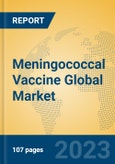Regional Market Trends
Meningococcal vaccine market trajectories vary by region, shaped by IMD incidence, immunization infrastructure, and epidemic histories.- North America: With a CAGR of 2.0%-4.0%, the United States leads consumption via CDC adolescent schedules and college mandates, emphasizing serogroup B coverage amid sporadic outbreaks.
- Europe: Growing at a CAGR of 1.5%-3.5%, the United Kingdom and Italy drive demand through national programs targeting infants and teens, with EU tenders supporting multivalent uptake.
- Asia-Pacific: Projected CAGR of 3.0%-5.0%, China and India propel growth via expanded EPI inclusions and urban serogroup surveillance, addressing rising W cases.
- Latin America: At a CAGR of 2.5%-4.5%, Brazil and Argentina benefit from PAHO-backed campaigns, focusing on conjugate introductions in indigenous communities.
- Middle East and Africa (MEA): Exhibiting a CAGR of 2.0%-4.0%, sub-Saharan Africa's meningitis belt, including Nigeria and Ethiopia, dominates via MenAfriVac rollouts, with Saudi Arabia's Hajj requirements boosting pentavalent demand despite logistical hurdles.
Type Analysis
The market segments by type, encompassing conjugation technologies and protein innovations for broad serogroup protection and age flexibility.- Conjugate vaccines: Linking polysaccharides to carrier proteins like CRM197 (Menveo by GSK), conjugates elicit robust T-dependent responses in toddlers, trending toward 4CMenB-MenACWY hybrids for single-dose efficiency and 90% seroprotection.
- Recombinant protein vaccines: Factor H binding protein-based (Bexsero by GSK), these target serogroup B via outer membrane vesicles, excelling in neonates with adjuvants enhancing cross-reactivity; developments focus on broad-spectrum OMV formulations against hypervirulent strains.
- Combination conjugate and recombinant protein vaccines: Integrating both (e.g., Penbraya by Pfizer), these penta-valent options simplify schedules, trending in high-burden areas for cost savings and compliance, with Phase IV data showing 95% effectiveness against diverse clones.
Company Profiles
- GlaxoSmithKline: GSK leads with Bexsero (MenB) and Menveo (MenACWY), its cornerstone meningococcal portfolio generating USD 1.2-1.6 billion in 2024 revenues, up double-digits amid European tenders and Bexsero surpassing USD 1 billion annually. Total vaccines sales contributed to GSK's USD 38 billion overall.
- Sanofi: Sanofi's MenQuadfi (MenACWY) and Menactra emphasize conjugate technology, with 2024 meningitis segment sales at €249 million, reflecting U.S. CDC shifts and pediatric expansions down to 6 weeks.
- Pfizer: Pfizer's Nimenrix (MenACWY) and Penbraya (penta-valent) target combination markets, with projections for USD 606 million by 2030, integrated into Pfizer's USD 63.6 billion 2024 revenues.
- Chongqing Zhifei Biological Products Co. Ltd.: As a Chinese innovator, Zhifei focuses on affordable MenACWY conjugates for domestic and Belt-and-Road exports.
- Cansino Biologics Inc.: Cansino develops recombinant MenB candidates, leveraging adenovirus platforms for rapid deployment in Asia.
- Walvax Biotechnology Co. Ltd.: Walvax advances low-cost polysaccharide vaccines, targeting emerging market tenders.
Industry Value Chain Analysis
The meningococcal vaccine value chain spans microbial antigen engineering to global immunization campaigns, underscoring public-private synergies. It initiates with R&D, utilizing bacterial genomics to sequence hyperinvasive lineages and design conjugates via glycoengineering, advancing through immunogenicity trials in outbreak simulations and WHO prequalification. Manufacturing involves fermentation of N. meningitidis in biosafety level 2 facilities, conjugation chemistry for protein-polysaccharide linkage, and aseptic filling with aluminum adjuvants, often via WHO-approved CDMOs for surge capacity. Supply chains prioritize antigen stability testing and lyophilization for tropical climates, with GAVI alliances buffering volumes for low-income countries. Regulatory processes include EMA/WHO fast-tracks for epidemics, followed by lot-release pharmacovigilance via VAERS-like systems. Marketing engages pediatricians and public health ministries through evidence dossiers on herd immunity thresholds (80-90%), distributed via UNICEF tenders and cold-chain pharmacies. End-delivery integrates school clinics and mobile units, with digital trackers for coverage monitoring. Leaders like GSK integrate upstream antigen production with downstream logistics, while Chinese firms like Zhifei optimize generics for affordability, addressing the chain's USD 500-800 million development costs and equity imperatives in epidemic belts.Opportunities and Challenges
Opportunities:
- Penta-Valent Adoption: 5-in-1 formulations could halve doses in adolescents, capturing USD 1 billion in U.S./EU markets by simplifying compliance.
- Epidemic Prevention: MenAfriVac extensions in Africa's belt offer scalable impact, with GAVI funding unlocking 20-30% volume surges.
- Adult Expansion: Travel and outbreak boosters in Asia-Pacific tap aging demographics, with recombinant tweaks enhancing durability.
- Tech Integration: mRNA platforms for universal Men vaccines could preempt variants, aligning with post-COVID manufacturing.
Challenges:
- Serogroup Shifts: Emerging X and non-B strains erode coverage, requiring vigilant surveillance amid delayed strain replacements.
- Supply Bottlenecks: Cold-chain failures in MEA cause 20% wastage, exacerbated by raw material dependencies on few suppliers.
- Hesitancy Barriers: Misinformation in Europe/Asia limits uptake to 70-80%, demanding targeted education amid anti-vax trends.
- Cost Containment: Pricing at USD 50-100/dose strains LMIC budgets, with tender competition pressuring margins despite volume pledges.
This product will be delivered within 1-3 business days.
Table of Contents
Companies Mentioned
- GlaxoSmithKline
- Sanofi
- Pfizer
- Chongqing Zhifei Biological Products Co. Ltd.
- Cansino Biologics Inc.
- Walvax Biotechnology Co. Ltd.








